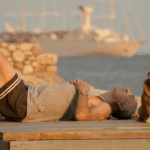
In Dubrovnik, “pomalo” isn’t just a holiday indulgence. It’s a philosophy of life that shapes everything from seaside swims to long lunches.
When I told my husband I needed a mumcation, he knew exactly where I’d go. My obsession with Croatia is no secret: I’ve lost count how many times I’ve visited my grandparents’ homeland (more than two dozen) and I even wrote a novel set there. Dubrovnik’s stari grad – the medieval walled old town – stole my heart when I first glimpsed it in 2001 on a holiday with my parents.
For my solo trip, I had a singular goal: to embody pomalo, a deeply ingrained Dalmatian lifestyle that emphasises a relaxed, unhurried approach. I needed to reconnect with myself away from my fast-paced New York City life.
“We wake up pomalo, we drink coffee pomalo, we eat pomalo, we spend time with our friends pomalo, we live pomalo,” said Ivan Vuković, my longtime friend and a local Dubrovnik tour guide. He cautioned me not to confuse pomalo with fjaka, a fleeting state akin to Italy’s dolce far niente (the sweetness of doing nothing).
“As a local, I would describe pomalo as much more than just ‘take it easy’,” echoed Deša Karamehmedović, PhD, an associate professor at the University of Herzegovina specialising in cultural tourism. “It is a mindset and a philosophy of life. It means slowing down, being present in the moment and savouring the simple joys without hurry.”
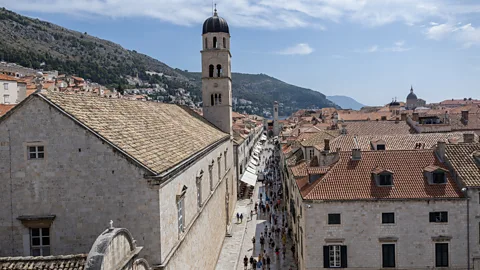
I was craving some unhurried time alone – a return to my people-watching days 21 years ago when I studied in Dubrovnik and wrote in my journal at Café Festival on Stradun, the old town’s main thoroughfare, lingering over a cup of coffee for hours. I wanted to reacquaint myself with the selves contained within me, ensconced like matryoshka nesting dolls: the university student who fell in love with Dubrovnik; the woman who got engaged and married there; the mum who celebrated her daughter’s first birthday at Restaurant Magdalena on the same terrace where we’d held our wedding reception.
I’m used to having a plan and itinerary, but this time, I simply bought a ticket for mid-August and booked a room at my favourite hotel. Apart from alerting Vuković and several friends of my trip, I had no real plans. After all, pomalo encourages you to go with the flow. “In Dubrovnik, it influences our daily rhythms – coffee is not rushed, conversations are not interrupted and life flows at its own pace,” Karamehmedović explained.
Pomalo feels distinctly Dalmatian, tied to the sea, the sun, the gentle povjetarac breeze and the slower island and coastal lifestyle. Karamehmedović believes it can even be a meaningful response to overtourism. “Instead of rushing through checklists, it invites travellers to deeply savour one place, one encounter, one moment and to enjoy every minute,” she said.
I’d been dreaming of swimming in the Adriatic and feeling saltwater on my skin, so on my first afternoon, Vuković and I headed straight for Titova villa beach on Lapad peninsula, where locals at Splendid beach bar lingered over beers and card games. The minute I dove into the clear water, my jet lag vanished and I felt refreshed and ready for a good night’s sleep.
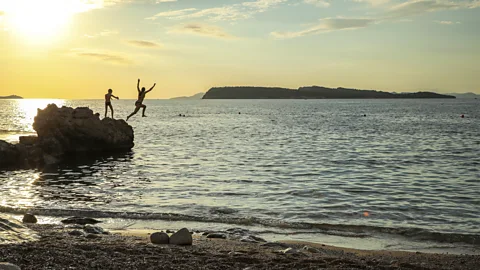
I was staying at Hotel Stari Grad, where I’d lodged on my first solo visit to Dubrovnik. The next morning, I climbed five flights to breakfast at the hotel’s rooftop restaurant. As I sipped coffee, I watched visitors walking the walls and locals shooting hoops on what is one of the most scenic basketball courts in the world. Much to my delight, there were fresh figs and organic eggs from the owners’ farm. I could have spent all morning watching the city awaken from my bird’s-eye view, but I was eager to see how the day would unfold.
The boutique hotel had changed hands since my first stay more than two decades ago, and Vuković introduced me to the new owners, Anna Slabovska and Sedi Fetahi, who shared their own Dubrovnik love story: they met in 2016 on Stradun and it was “love at first sight”, Slabovska said. “We fell head over heels for Dubrovnik.”
Born in Ukraine and ex-Yugoslavia respectively, they had to learn pomalo after years living in the UK and Switzerland. “It turns out what we truly needed was a dose of the ‘pomalo’ lifestyle,” Slabovska said.
I was eager for adventure and quickly agreed to tag along when they invited me to see their renovation project – a holiday villa perched on a secluded bay in Kobaš village on the Pelješac peninsula, about a 90-minute drive from the old town. “We are designing the [guest] experience around the essence of pomalo,” Slabovska said. “The tension melts. Their rhythm softens. They notice the light, the sea, the silence. That’s the moment pomalo begins to work its quiet magic.”
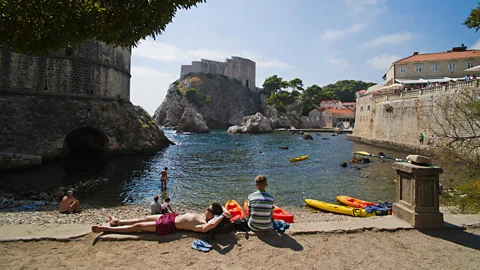
On the way, we stopped to see their chickens and their fruit and vegetable garden in Ston, where they grow much of the produce used in the hotel restaurant. We spent the afternoon swimming and munching on fresh figs while their young son zipped around the seaside promenade on his new scooter, ending with a pasta meal whipped up by Fetahi with meatballs made by Slabovska’s mother who was visiting from Ukraine. By the end of the day, pomalo had started to work its magic on me: my overactive mind slowed, my shoulders softened and I started paying attention to the rhythm of my breath as I gazed at the shimmering sea.
How to experience pomalo in Dubrovnik
Linger over coffee or cocktails: Spend hours people-watching in a café on Stradun, or sip prosecco with sea views at Fratellos Restaurant and Bar.
Swim like a local: Head to Lapad peninsula or Cavtat for late-afternoon dips in the Adriatic.
Stretch out meals: Order fresh fish with blitva (Swiss chard) or the traditional Dubrovnik dish šporki makaruli (“dirty pasta”) and sip local wine slowly over lunch.
Take the scenic route: Ride the ferry to Cavtat, take a day trip to the Pelješac peninsula for wine and oysters or simply stroll the old town without a set itinerary.
“In Dubrovnik we have a saying: ‘Pomalo, vrag odnio prešu!’ meaning ‘Slowly, the devil takes the rush!’” said author Jadranka Ničetić, who has written extensively about the region’s gastronomy, traditions and recipes. “The slow-paced lifestyle is reflected in our everyday lives because it runs in our genes.”
Meals in Dubrovnik epitomise pomalo. “We do not allow the hectic pace of the city to dictate the pace at the table,” Ničetić said. Last-minute on a Saturday afternoon, I met my writer friend Vesna Jakšić Lowe, who grew up here, for a long lunch at Restaurant Orsan on Lapad peninsula, where we sipped locally cultivated pošip wine and nibbled on octopus salad and local cheese. In the crushing afternoon heat, we slowly meandered to her family home and lazed on the stone terrace overlooking the sea.
Later, we reconvened in the old town for an impromptu evening at M’arden, a wine bar on a cloistered, leaf-shaded terrace. Back in New York, we usually squeeze in catchups or writing afternoons before school pickups. But that evening, we luxuriated in conversation without a deadline and lingered over glasses of wine until closing.
I discovered my university friend Tristan Perich was also visiting Dubrovnik, and we made a plan to meet for swimming and Sunday dinner. Although we both live in New York City, we hadn’t seen each other for at least a decade.
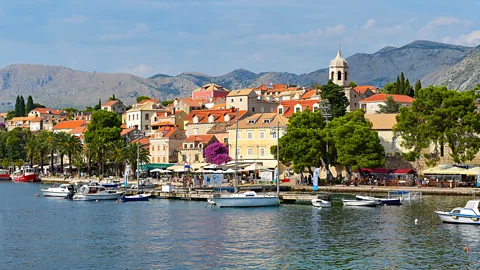
In the spirit of pomalo, I took the scenic 45-minute ferry to Cavtat, a historic seaside town, stopping for a glass of wine at Wine Bar Banac with my friend Vlaho Carević, the founder and CEO of Habitat Distillery, Dubrovnik’s first small-batch artisanal gin.
“As a distiller, [pomalo] shapes everything I do,” Carević said. “It means striving for balance, refining methods and drawing out flavours that go beyond taste alone – flavours that spark real emotions in the person experiencing them. In that way, pomalo is both my philosophy of life and the essence behind every spirit we create.”
More like this:
• Dalmatia’s fjaka state of mind
• Disneyland to living city: Dubrovnik’s bold fight against overtourism
• Living in: The world’s greatest walled cities
Later, Carević drove me to Perich’s family home in Mikulići. I swam in the sea with his family at Prevlaka near the Montenegro border, and then we all had dinner at Konavoski Dvori Eco Green Restaurant, situated on the grounds of an ancient mill adjacent to the Ljuta river. Perich and I took a stroll with his son on a trail through the darkening woods, imbibing the pristine nature and soothing gurgles from the river, attempting to catch up on a decade’s worth of life. Back at the table with his wife and daughter, we relished homemade bread with kajmak (a rich, creamy dairy product) and freshly caught grilled trout.
“So glad we got a real hang in after all these years,” Perich wrote to me after I returned home.
And that’s pomalo, distilled: enjoying life at a leisurely pace, finding joy in authentic connection and savouring each moment.
As Ničetić reminded me: “Why rush when you can enjoy life?”


